Most of us have a love-hate relationship with our Mass Rapid Transit (MRT). On one hand, we depend on this world class transportation for our daily commute which, on an average day, works pretty well. On the other, you know things are going south when the MRT gets turned into a meme.
Next year marks 30 years since the launch of our first MRT line, and what a ride it has been through the ups and downs. We take a step back in time with these stories of the MRT that you might hear from your grandparents.
A $5 billion price tag
What is the best way to transport your citizens around? The government set out to answer that with the Singapore Mass Transit Study in 1972. The end result of that study was the recommendation that Singapore develop a rail system, that in conjunction with bus services, would support our anticipated growing travel demand.
However, not everyone was enthusiastic about the idea of a rail system - particularly the estimated $5 billion price tag. It took another 10 years, after more studies and debates before permission was granted to build Singapore's largest public project in 1982.
Opening day
The construction and operation of the MRT was overseen by the Mass Rapid Transit Corporation (MRTC)The operation of the MRT was later handed over to the then newly incorporated Singapore Mass Rapid Transit Limited (SMRT) a few months before the official opening of the MRT line.
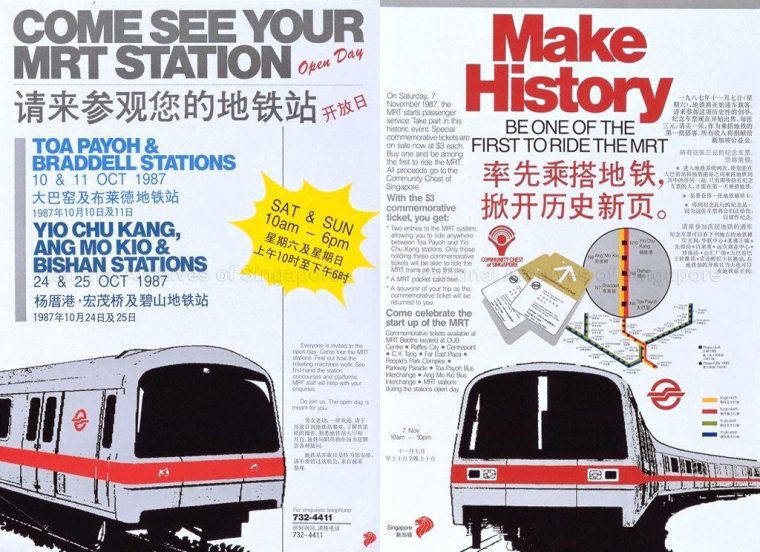 Posters on preview of the MRT stations before their official opening (left) and the official launch of the North-South Line (right). Taken from National Archives Singapore.
Posters on preview of the MRT stations before their official opening (left) and the official launch of the North-South Line (right). Taken from National Archives Singapore.
The first section of the MRT that was launched on 7 November 1987 for passenger service was the stretch between Yio Chu Kang and Toa Payoh. It was a huge hit. There was even a couple who turned up in their wedding finery on opening day. Within three weeks of the opening of the MRT line, the operator recorded their millionth ride!
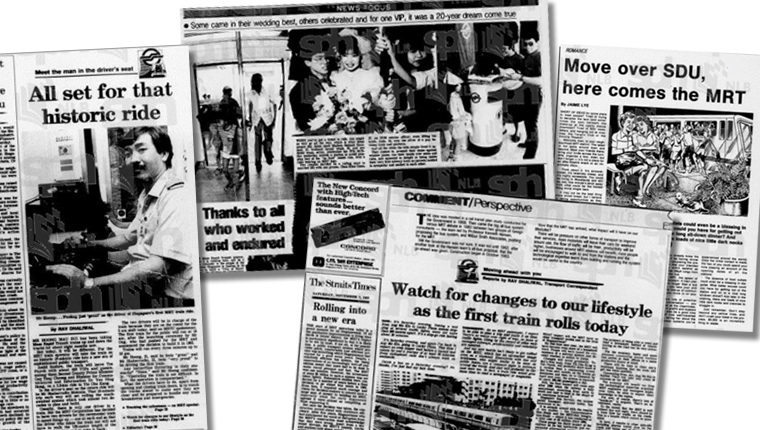 Newspaper articles on the opening of the MRT line. Digitised articles taken from NewspaperSG.
Newspaper articles on the opening of the MRT line. Digitised articles taken from NewspaperSG.
Meet you at N8 Bishan?
The MRT system grew rapidly and by 1990, the approved MRT network consisting of 42 stations spread across three lines was completed ahead of schedule.
Back in those days, station codes were a lot less complicated. The alpha-numeric codes consisted of a letter denoting direction (e.g. 'W' for West-bound; 'N' for North-bound) and numbers which ascended as the lines radiated outward from the city centre.
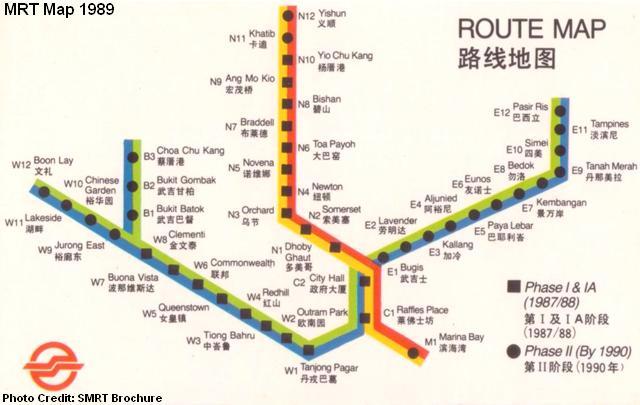 A 1989 MRT Route Map featuring early versions of the North-South and East-West Lines before the addition of Woodlands Extension to link Choa Chu Kang and Yishun stations. Taken from Remember Singapore.
A 1989 MRT Route Map featuring early versions of the North-South and East-West Lines before the addition of Woodlands Extension to link Choa Chu Kang and Yishun stations. Taken from Remember Singapore.
‘Please mind the platform gap’
MRT announcements were introduced in 1994. MRT commuters in the 90s would remember the distinct yet familiar voice that belongs to Juanita Melson reminding passengers to ‘please mind the platform gap’. Today, we are more accustomed to the voice of Chan Hui Yuh who replaced Melson in 2008.
Melson gives us a short demo of her 'announcement voice' in the deleted scene below from Tan Pin Pin's Singapore GaGa.
Plastic farecards
Throughout the 90s, plastic magnetic stripe farecards were used for travelling on public transport. Farecards had stored value that could be used on trains and buses.
At the MRT stations, commuters could also purchase single trip tickets from ticketing machines (which only accepted coins!) like the ones below. At the faregates, commuters had to insert their farecards into a thin slot before the gates would open to admit them.
Since the early 2000s, magnetic stripe farecards were slowly phased out and replaced by the contactless farecards, such as those by EZ-Link and NETS FlashPay.
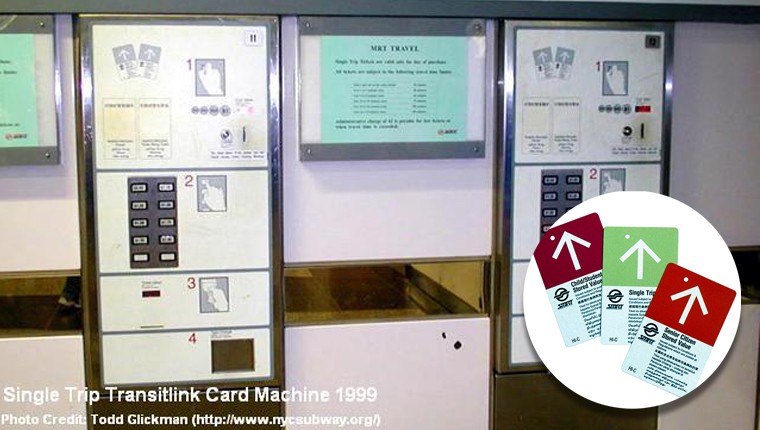 Single ticket Transitlink machine. Image adapted from Remember Singapore.
Single ticket Transitlink machine. Image adapted from Remember Singapore.
Bumpy ride
It wasn't always a smooth ride for the MRT though.
On 5 August 1993, the MRT saw its first major accident when a train collision occurred at Clementi station in the early morning due to an oil spill. Passengers were flung around inside the train and piled on top of each other. The accident resulted in 156 reported injuries.
More recently since 2011, it seems that more incidents on the MRT have reportedly been occurring. Many would remember the severe disruptions in December 2011 and July 2015 which resulted in stranded commuters across the entire North-South and East-West Lines. Investigations pointed to lapses in maintenance as the root cause.
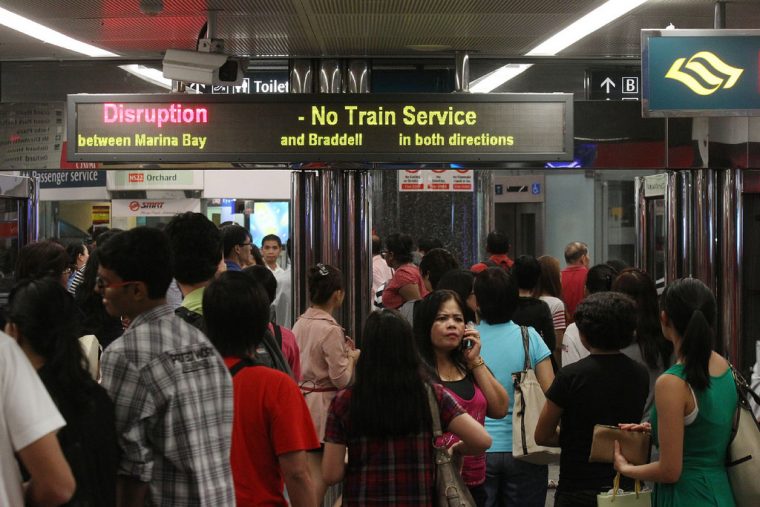 Train service disruption. Taken from Flickr.
Train service disruption. Taken from Flickr.
A better MRT experience?
As the population grew, MRT ridership also increased, which put a strain on our rail system. In order to keep the trains and other parts of the system regularly upgraded and replaced to ensure reliable train services for commuters, the government announced the New Rail Financing Framework (NRFF) in 2008.
In short, for rail lines under the NRFF, the LTA owns all trains, signalling systems, maintenance equipment, and infrastructure. Meanwhile, operators focus on running and maintaining the rail network (read: things shouldn’t break down as often).
In a way, the roles that government and operators play in the rail system will be made clearer, with both sides being able to do what they do best. By taking over the rail assets, the LTA can ensure that timely improvements to the trains and tracks are made. With better rides, hopefully we might have some good MRT experiences to share with our own grandchildren.
This sponsored post helps fuel Mothership’s writers who depend on reliable MRT rides so that we can go home on time.
Top photos taken from National Archives Singapore.
If you like what you read, follow us on Facebook and Twitter to get the latest updates.
If you like what you read, follow us on Facebook, Instagram, Twitter and Telegram to get the latest updates.
